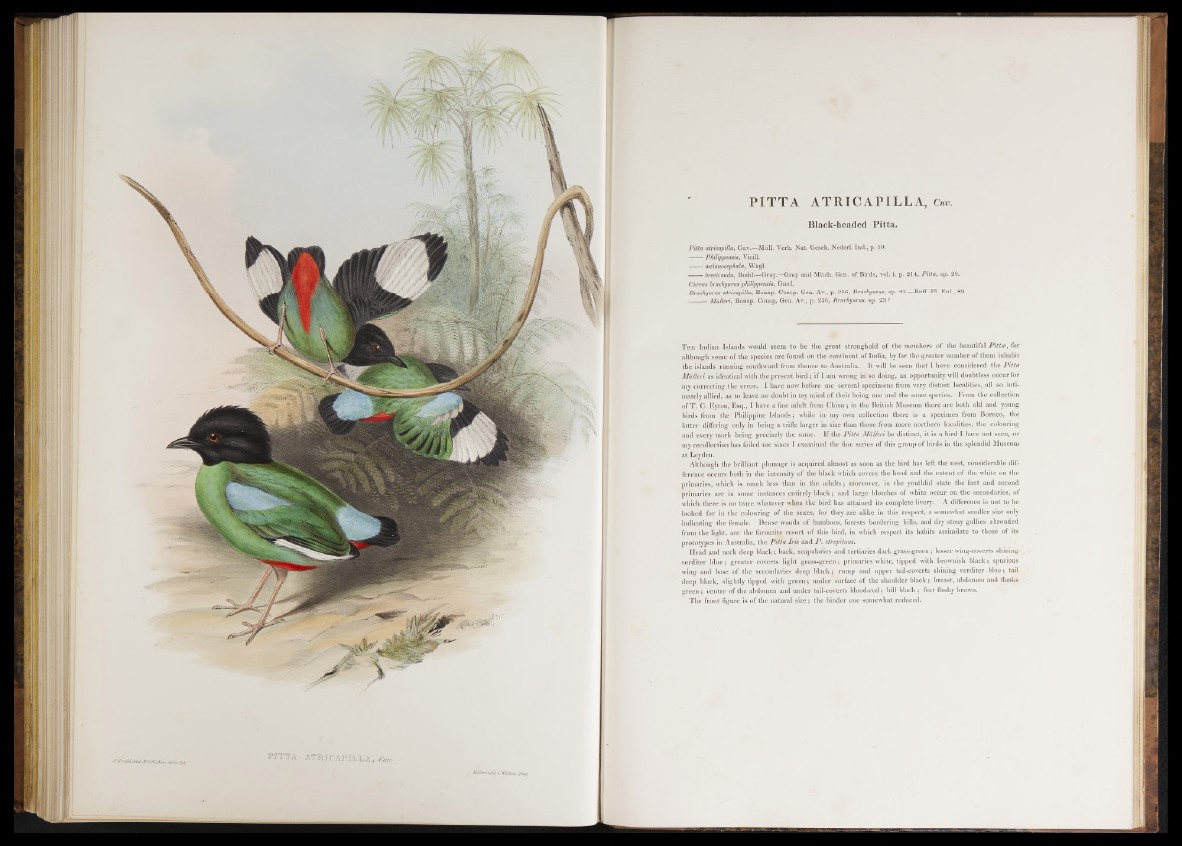
c/.GouM¿mrfJrcJtfcAea; ddet&A P I T T A A T B I C A M J L IA , CuW,
/fuG,*cnM k Waton, T«y,
PITTA ATRICAPILLA, Cuv.
Black-headed P itta .
Pitta atricapilla, Cuv.—Müll. Verh. Nat. Gesch. Nederl. Ind., p. 19.
Philippensis, Vieill.
melanocephala, Wagl.
brevicauda, Bodd.—Gray.—Gray and Mitch. Gen. of B irds, vol. i. p. 214, Pitta, sp. 28.
Corvus brachyurus philippensis, Gmel.
Brachyurus atricapilla, Bonap. Consp. Gen. Av., p. 256, Brachyurus, sp. 25.—Buff. PI. Enl., 89.
Mulleri, Bonap. Consp, Gen. Av., p. 256, Brachyurus. sp. 23 ?
T h e Indian Islands would seem to be the great stronghold of the members of the beautiful Pittoe, for
although some of the species are found on the continent o f India, by far the g reater number of them inhabit
the islands running southward from thence to Australia. I t will be seen that I have considered the Pitta
Mulleri as identical with the present b ird ; if I am wrong in so doing, an opportunity will doubtless occur for
my correcting the error. I have now before me several specimens from very distant localities, all so intimately
allied, as to leave no doubt in my mind o f their being one and the same species. From the collection
of T. C. Eyton,' Esq., I have a fine adult from China; in the British Museum there are both old and young
birds from the Philippine Islands; while in my own collection there is a specimen from Borneo, the
latter differing only in being a trifle larger in size than those from more northern localities, the colouring
and every mark being precisely the same. If the P itta Mulleri be distinct, it is a bird I have not seen, or
my recollection has failed me since I examined the fine series of this group of birds in the splendid Museum
a t Leyden;
Although the brilliant plumage is acquired almost as soon as the bird has left the nest, considerable difference
occurs both in the intensity of the black which covers the head and the extent of the white on the
primaries, which is much less than in the ad u lts; moreover, in the youthful state the first and second
primaries are in some instances entirely black; and large blotches of white occur on the secondaries, of
which there is no trace whatever when the bird has attained its complete livery. A difference is not to be
looked for in the colouring of the sexes, for they are alike in this respect, a somewhat smaller size only
indicating the female. Dense woods of bamboos, forests bordering hills, and dry stony gullies shrouded
from the light, are the favourite resort of this bird, in which respect its habits assimilate to those of its
prototypes in Australia, the Pitta Iris and P . strepitans.
Head and neck deep b lack ; back, scapularies and tertiaries dark grass-green; lesser wing-coverts shining
verditer b lu e ; greater coverts light grass-green; primaries white, tipped with brownish black; spurious
wing and base of the secondaries deep b lack ; rump and upper tail-coverts shining verditer blue; tail
deep black, slightly tipped with g reen ; under surface of the shoulder black; breast, abdomen and flanks
green ; centre of the abdomen and under tail-coverts blood-red; bill black ; feet fleshy brown.
The front figure is o f the natural size; the hinder one somewhat reduced.